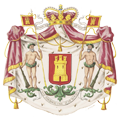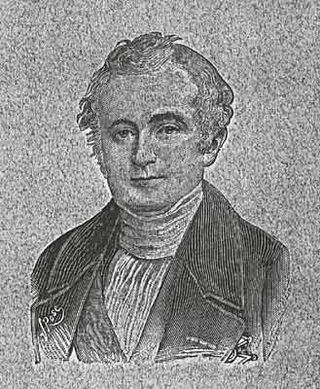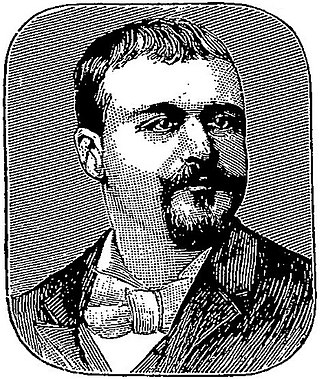
Albert Auguste Gabriel Hanotaux, known as Gabriel Hanotaux was a French statesman and historian.

Marie Ernest Paul Boniface de Castellane, Marquis de Castellane, known as Boni de Castellane, was a French nobleman and politician. He was known as a leading Belle Époque tastemaker and the first husband of American railroad heiress Anna Gould.

Castellane is a commune in the Alpes-de-Haute-Provence department in the Provence-Alpes-Côte d'Azur region in Southeastern France. With a population of 1,470 (2019), it has the distinction of being France's least populated subprefecture, ahead of Largentière in Ardèche.

Tomás Terry y Adán was a Cuban business magnate.
Emilio Rene Terry y Sánchez (1890–1969), known as Emilio Terry was a French architect, artist, interior decorator and landscape designer of Cuban-Irish ancestry. Creating furniture, tapestries and objets d'art, he was influenced by the château de Chenonceau, acquired by his family, and he created a style that was at once classical and baroque, which he called the "Louis XVII style".

The Château de Rochecotte is a late 18th-century château located in the French village of Saint-Patrice, near Langeais, in Indre-et-Loire. It is known for its various owners and their many successive rebuilds.
Joséphine Pauline de Talleyrand-Périgord, Marquise de Castellane was a French noblewoman.

The House of Castellane is a very ancient French noble house originating in Provence and descended from Thibault, count of Arles in the 9th century.

Princess Marie Radziwill was a French noblewoman, a member of the house of Castellane. The famous dandy Boni de Castellane was her nephew.

Félix Barthe was a French lawyer, Deputy, Minister of Public Education and then Minister of Justice. He was the first President of the Court of Accounts and became a Senator of the Second French Empire.

Nicolas Martin du Nord was a French magistrate and politician. He was Minister of Public Works, Agriculture and Commerce (1835–39) and Minister of Justice and Religious Affairs (1840–47).

Jules Godin was a French lawyer and politician of the French Third Republic. He was Deputy of French India from 1876 to 1881 and Senator of French India from 1891 to 1909. He was briefly Minister of Public Works in 1898.

Henri Barbet, or Henry Barbet, was a French industrialist and politician. He owned and ran the family cotton spinning and weaving factory in Rouen, one of the most important in the region. For many years he was mayor of Rouen. He was responsible for building two bridges over the Seine, and for a policy of putting the indigent and insane to work in charitable workshops. He was a deputy for the Seine during the July Monarchy and again during the Second French Empire.
Marquis Boniface Antoine de Castellane was a French aristocrat, most notable as deputy for Cantal and as father of Boni de Castellane.

Jean de Castellane was a French politician and member of the house of Castellane. In 1898 he married Dorothée de Talleyrand-Périgord. He was born and died in Paris.

Arthur Legrand was a French lawyer, public servant and politician who represented Manche in the legislature almost continuously from 1871 to his death in 1916. His political beliefs were Bonapartist and conservative at first, and later he ran as an independent..

Stéphane Christophe Mony was a French railway engineer, company president and politician. He was involved in the Saint-Simonian movement when a young man. He was trained as an engineer, and he and his half brother Eugène Flachat built the Paris-Saint Germain and Paris-Versailles railway lines between 1833 and 1840. He was then appointed head of the Commentry mining company, later Commentry-Fourchambault, a position he held until his death. He was elected to the legislature towards the end of the Second French Empire, from 1868 to 1870. He did not succeed in getting reelected in the French Third Republic.

Pierre-Philippe-Alexandre Panon Desbassyns de Richemont was a French archaeologist, historian and politician. Between 1871 and 1882 he represented French India first in the National Assembly and then in the Senate.

Jules Philippe Louis Albert Grévy was a French lawyer and politician. He represented Doubs in the National Assembly and then the Chamber of Deputies from 1871 to 1880. He was Governor-General of Algeria from 1879 to 1881, and a Senator for Life from 1880 until his death in 1899.

Antoine Benoît François Deloncle was a French orientalist, journalist, diplomat and politician who was Deputy for Basses-Alpes from 1889 to 1898, Deputy for Cochinchina from 1902 to 1910, and again Deputy for Basses-Alpes from 1912 to 1914. He was a member of the groupe colonial, in favour of expanding and consolidating the French colonial empire and opposed to the rival British Empire. He portrayed the British as oppressive despots compared to the civilized and tolerant French.

















